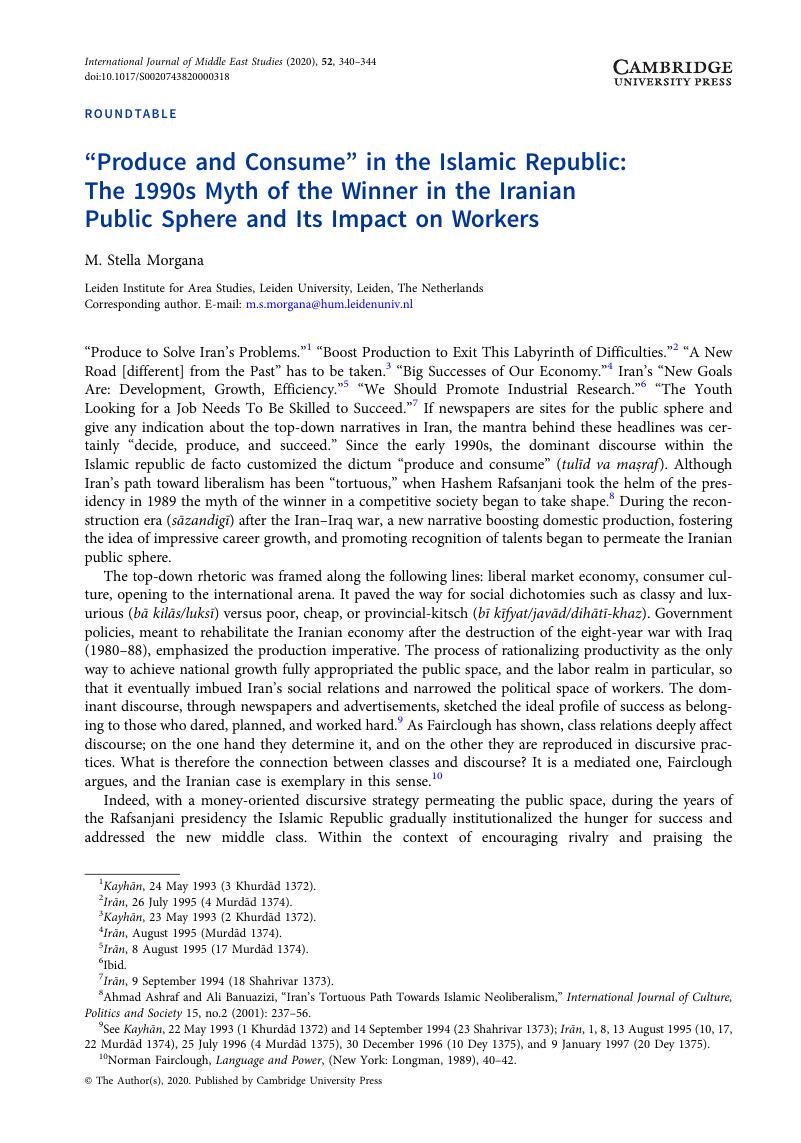Article contents
“Produce and Consume” in the Islamic Republic: The 1990s Myth of the Winner in the Iranian Public Sphere and Its Impact on Workers
Published online by Cambridge University Press: 28 May 2020
Abstract

- Type
- Roundtable
- Information
- Copyright
- Copyright © The Author(s), 2020. Published by Cambridge University Press
References
1 Kayhān, 24 May 1993 (3 Khurdād 1372).
2 Irān, 26 July 1995 (4 Murdād 1374).
3 Kayhān, 23 May 1993 (2 Khurdād 1372).
4 Irān, August 1995 (Murdād 1374).
5 Irān, 8 August 1995 (17 Murdād 1374).
6 Ibid.
7 Irān, 9 September 1994 (18 Shahrivar 1373).
8 Ashraf, Ahmad and Banuazizi, Ali, “Iran's Tortuous Path Towards Islamic Neoliberalism,” International Journal of Culture, Politics and Society 15, no. 2 (2001): 237–56CrossRefGoogle Scholar.
9 See Kayhān, 22 May 1993 (1 Khurdād 1372) and 14 September 1994 (23 Shahrivar 1373); Irān, 1, 8, 13 August 1995 (10, 17, 22 Murdād 1374), 25 July 1996 (4 Murdād 1375), 30 December 1996 (10 Dey 1375), and 9 January 1997 (20 Dey 1375).
10 Fairclough, Norman, Language and Power, (New York: Longman, 1989), 40–42Google Scholar.
11 Reuters, 30 July 1989.
12 Abrahamian, Ervand, History of Modern Iran (New York: Cambridge University Press, 2008), 182–83CrossRefGoogle Scholar.
13 Kayhān, 30 April 1990 (10 Urdibihisht 1369). See also M. Stella Morgana, “Talking to Workers: From Khomeini to Ahmadinejad: How the Islamic Republic's Discourse on Labor Changed through May Day Speeches (1979‒2009),” Iranian Studies 52, no. 1–2 (2019): 133–58, doi:10.1080/00210862.2019.1599713.
14 Salām, 1 May 1994 (11 Urdibihisht 1373).
15 Irān, 26 July 1995 and 16 August 1995 (4–25 Murdād 1374); Hamshahri, 29 June 1996 (9 Tir 1375).
16 Kār-o-Kārgar, 2 January 1992 (12 Dey 1370), 7 October 1993 (15 Mihr 1372), and 4 August 1996 (14 Murdād 1375); “Violence Spreads in Iran as the Poor Are Evicted,” New York Times, 1 June 1992, https://www.nytimes.com/1992/06/01/world/violence-spreads-in-iran-as-the-poor-are-evicted.html. See also Asef Bayat, Street Politics: Poor People's Movements in Iran (New York: Columbia University Press, 1997), 97–99.
17 Irān, 2 August 1995 (11 Murdād 1374) and 24 November 1996 (4 Azar 1375).
18 See Khosravi, Shahram, Precarious Lives: Waiting and Hope in Iran (Philadelphia: University of Pennsylvania Press, 2017), 11–12CrossRefGoogle Scholar, 214.
19 Kayhān, 14 June 1994 (24 Khurdād 1373).
20 Irān, 24 July 1995 (2 Murdād 1374).
21 Irān and Hamshahri, 1 August 1995 (10 Murdād 1374).
22 Irān and Hamshahri, 23 August 1995 (1 Shahrivar 1374).
23 Irān, 26 July 1995 (4 Murdād 1374).
24 Irān, 28 July 1995 (6 Murdād 1374).
25 Hamshahri, July–August 1995, (Murdād 1374). See also Adelkhah, Fariba, Being Modern in Iran (London: Hurst, 1999), 139–60Google Scholar.
26 Amouzadeh, Mohammad and Tavangar, Manouchehr, “Decoding Pictorial Metaphor Ideologies in Persian Commercial Advertising,” International Journal of Cultural Studies 7, no. 2 (2004): 147–74CrossRefGoogle Scholar.
27 Irān and IRNA, 2 August 1995 (11 Murdād 1374).
28 Irān and IRNA, 8 August 1995 (17 Murdād 1374).
29 Hamshari and Irān, August 1995 (Murdād 1374), December 1996 (Azar 1375), January 1997 (Dey 1375), and May 1997 (Urdibihisht 1376).
30 Hamshahri, Kitab-i Sāl 1375 and 1376 (Tehran: Hamshahri, 1999). See also Irān, 13 August 1995 (22 Murdād 1374), 1 January 1997 (12 Dey 1375), and 26 August 1997 (4 Shahrivar 1376).
31 Ehsani, Kaveh, “Municipal Matters: The Urbanization of Consciousness and Political Change in Tehran,” Middle East Report 212 (1999), 22–27CrossRefGoogle Scholar.
32 Ibid., 24.
- 3
- Cited by


